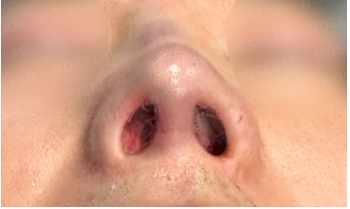Hello, this is Dr. Cha-Young Kang, Director of Nose Lab Clinic.
Today, I’d like to share the case of a patient who came to us after experiencing structural issues and asymmetry following a hump nose surgery. This case serves as a guide for those considering revision surgery for similar concerns.
1. Surgical History and Patient Goals

Pre-Surgery Consultation: Frontal View, Left Side View, and Oblique Side View Photos
The patient underwent a hump nose correction, along with surgery for deviated septum and rhinitis, at another clinic in 2017. After the initial surgery, the patient suffered from an uneven nasal bridge, worsened nostril asymmetry, and an upturned nose. The primary goal was to achieve natural, symmetrical results that would eliminate the need for further revisions.
2. Diagnosis and Surgical Plan
Upon examination, we identified the following issues:
Septal cartilage damage, leading to a tilted columella (deviation to the left).
Overcorrection of the keystone area, resulting in structural instability of the nose.

Saddle nose deformity due to prior cartilage damage.
Surgical Plan:To address these issues, we devised a comprehensive plan:
Osteotomy to straighten and narrow the nose.
Rib cartilage grafting on the right side of the anterior nasal spine for septal reconstruction and stability.
Septal deviation correction by shifting the septum to the right.
Columella scar tissue removal to smooth the tip and enhance its contour.
Keystone reconstruction to restore overall nasal stability.

Before (Left) / Immediately After (Right)

Before (Left) / Immediately After (Right)

Before (Left) / Immediately After (Right)

Before (Left) / Immediately After (Right)
3. Surgical Outcomes and Patient Feedback
Immediately post-surgery, the following improvements were observed:
Front View: The nostrils appeared less exposed, and the previously uneven bridge was significantly smoother.
Side View: The saddle nose deformity was corrected, creating a balanced nasal bridge and a more aesthetically pleasing nasolabial angle. The lips also appeared less protruded as a result.

Saddle Nose Deformity Photos
Overall Contour: A sleek and natural nasal bridge complemented the facial features.
Nostril View: Asymmetry was markedly reduced, and the columella was repositioned to align symmetrically with the face.

Immediately After Surgery: Frontal, Oblique Side, and Side View Photos

Immediately After Surgery: Nostril View Photos
4. Key Considerations for Hump Nose Revision
Revision surgery for hump nose correction requires a delicate balance between aesthetic and structural goals. Overcorrection can destabilize the nasal framework, leading to complications such as asymmetry, collapse, or breathing issues.
The keystone area, in particular, must be preserved or reconstructed to ensure long-term stability. Augmenting cartilage or using implants as needed can help address deficiencies without over-altering the nose’s natural anatomy.
5. Conclusion
Revision surgery for hump nose correction and asymmetry is a complex yet rewarding process when approached with precision and care. At Nose Lab Clinic, we focus on tailored solutions that align with the patient’s facial structure and functional needs, ensuring results that are both natural and long-lasting.
If you are considering revision surgery, we invite you to consult with our experienced team to design a personalized treatment plan. With expertise in both primary and complex revision rhinoplasty, we are committed to helping you achieve the confidence and harmony you seek.
Thank you for reading. This is Dr. Cha-Young Kang from Nose Lab Clinic.


コメント